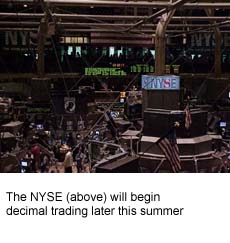|
Decimal trades now online
|
 |
July 3, 2000: 3:57 p.m. ET
Island ECN becomes first U.S. trading network to abandon fractions
|
NEW YORK (CNNfn) - U.S. investors began trading stocks in decimals for the first time Monday as Island ECN, the electronic communications network of Datek Online Holdings Inc., became the first trading network in the United States to convert to decimals from fractions.
The switch, which comes ahead of the New York Stock Exchange and the Nasdaq, allows traders to buy and sell stocks in 1 cent increments, virtually eliminating the spread between what investors bid and what they actually pay for a stock, which can be costly under the fractional trading system.
Under the new decimal system, a stock currently priced at 20-1/4 would be priced at $20.25. In addition to being more precise, decimal pricing would put U.S. markets more in line with other markets around the world, government officials have said.
 Also, there will be no more fumbling for the calculator to divide fractions and figure out minute calculations while trading stocks. Also, there will be no more fumbling for the calculator to divide fractions and figure out minute calculations while trading stocks.
"Quite simply, we've allowed investors to place their limit orders in pennies rather than in fractions," Edward Nicoll, chief executive officer of Datek Online Holdings told CNNfn's N.E.W. Show Monday. "Up till now, on a stock at 10 or over, investors were limited to entering orders in sixteenths, which is six-and-a-quarter cents. What we've allowed them to do today is to enter their order in pennies. This sounds like a simple idea, but it has a major impact on the markets and a major impact on investors."
The New York Stock Exchange plans to initiate a pilot decimal trading system later this summer. The Nasdaq also has plans to convert.
"It's more easily understood by investors. It puts us on the same pricing platform as non-U.S. markets," said Ray Pellechia, a NYSE spokesman.
A Nasdaq spokesman could not be reached for comment Monday.
New York-based Island, the second-largest electronic stock trading system, has been pushing for decimal trading, which it said makes far more sense than the antiquated fraction system. The United States is the only country still trading in fractions.
The fractional trading system dates back to the earliest days in the United States when the Spanish dollar was the dominant currency, Pellechia said. The Spanish dollar could be physically split into what were called "pieces of eight" - establishing eighths as the fractional base for trading stocks. Three years ago that was changed to sixteenths.
But now that decimals have arrived, experts expect a lot less confusion.
"It's certainly more intuitive and reasonable to go with decimals," said Cameron Smith, Island ECN's general counsel. "We think it's just a benefit that will accrue to investors in the form of narrow spreads."
Last month, the Securities and Exchange Commission ordered the major U.S. stock markets to begin listing stock prices using a decimal system no later than April 9, 2001.
That's a revised deadline set after the National Association of Securities Dealers, Nasdaq's parent, said in March that it will not meet a July 3 deadline to begin decimal trading because of problems upgrading in technology.
But not everyone is thrilled with the prospect of switching to decimals.
When trading increments get smaller, spreads, the difference between a stock's bid and asking price, tend to narrow. So switching to smaller increments, which decimals involve, would tighten spreads. That cuts profits for middlemen such as market makers. It leads to greater efficiency and better prices for investors.
The theory is that when increments are high -- say, you can only change your price $1 at a time -- you are less inclined to improve your price often. But if you can change your price at less dramatic levels -- say every 5 cents -- you are more willing to cut your best price, and change your price more often, to stay competitive.
"Wall Street has always profited from the spreads that are created, artificially high spreads that are created from fractions, and they've never had any incentive to move to decimalization before," Nicoll said.
"We give our investors a tremendous trading advantage. They have the ability to bid in pennies when everybody else is limited to sixteenths and eighths, and that's a tremendous trading advantage." 
|
|
|
|
|
 |

|

